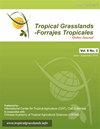种子结构对杂交种‘MulatoⅡ’种子休眠的影响
IF 0.7
4区 农林科学
Q3 AGRICULTURE, DAIRY & ANIMAL SCIENCE
引用次数: 1
摘要
本研究以杂交种“Mulato II”为材料,研究了种子结构对种子休眠的影响,并对打破休眠的方法进行了试验。研究了在室内环境条件下贮存10个月的种子结构对种子萌发和透水性的影响。结果表明,种子结构对水分渗透具有一定的阻碍作用。去除外稃、刺破种皮、去除种子结构和硫酸浸泡均可减少种子休眠。种子不同部位的水提物和醇提物对北京芸苔种子萌发有抑制作用。种子休眠机制主要有3种;首先,种子结构的机械屏障,排除水分,减少气体交换,限制了胚胎的生长;二是内源性发芽抑制因子,主要存在于外稃中;第三,种皮(包括果皮和种皮)的透水性。机械去除外稃和浸泡在浓硫酸中可以减少种子的休眠,但单独机械去除外稃更有效、方便和安全。本文章由计算机程序翻译,如有差异,请以英文原文为准。
The influence of seed structures on dormancy in seeds of Urochloa hybrid cultivar ‘Mulato Ⅱ’
This study determined the effects of seed structures on seed dormancy and tested methods to break dormancy in seeds of Urochloa hybrid cultivar ‘Mulato II’. Seeds stored for 10 months in indoor ambient conditions were studied to determine effects of seed structures on seed germination and their water permeability. Results showed that seed structures presented a barrier to water permeability. Removal of lemmas, puncturing the seed coat, seed structure removal and sulfuric acid immersion all reduced seed dormancy. Water and alcohol extracts from different parts of seeds inhibited seed germination of Brassica pekinensis seeds. There were 3 mechanisms responsible for seed dormancy; first, the mechanical barrier of seed structures, which excluded water and reduced gas exchange as well as restricting growth of the embryo; second, an endogenous germination inhibitor mainly found in lemmas; and third, water permeability of the seed coat (including pericarp and testa). The mechanical removal of lemmas and immersion in concentrated sulfuric acid reduced seed dormancy, although mechanical removal of the lemma alone was effective, convenient and safer.
求助全文
通过发布文献求助,成功后即可免费获取论文全文。
去求助
来源期刊

Tropical Grasslands-Forrajes Tropicales
Agricultural and Biological Sciences-Agronomy and Crop Science
CiteScore
1.60
自引率
0.00%
发文量
36
审稿时长
16 weeks
期刊介绍:
The Journal publishes, in English or Spanish, Research Papers and Short Communications on research and development, as well as contributions from practitioners (Farmer Contributions) and Review Articles, related to pastures and forages in the tropics and subtropics. There is no regional focus; the information published should be of interest to a wide readership, encomprising researchers, academics, students, technicians, development workers and farmers.
In general, the focus of the Journal is more on sown (''improved'') pastures and forages than on rangeland-specific aspects of natural grasslands, but exceptions are possible (e.g. when a submission is relevant for a particularly broad readership in the pasture and forage science community).
The Journal will also consider the occasional publication of associated, but closely related, research in the form of an additional scientific communication platform [e.g. a re-make of the former Genetic Resources Communication series of the former Division of Tropical Crops and Pastures of the Commonwealth Scientific and Industrial Research Organisation (CSIRO), Australia].
Areas of particular interest to the Journal are:
Forage Genetic Resources and Livestock Production[...]
Environmental Functions of Forages[...]
Socio-economic Aspects[...]
Topics within the aforementioned areas may include: Diversity evaluation; Agronomy; Establishment (including fertilization); Management and utilization; Animal production; Nutritive value; Biotic stresses (pests and diseases, weeds); Abiotic stresses (soil fertility, water, temperature); Genetics and breeding; Biogeography and germplasm collections; Seed production; Ecology; Physiology; Rhizobiology (including BNF, BNI, mycorrhizae); Forage conservation; Economics; Multilocational experimentation; Modelling.
 求助内容:
求助内容: 应助结果提醒方式:
应助结果提醒方式:


